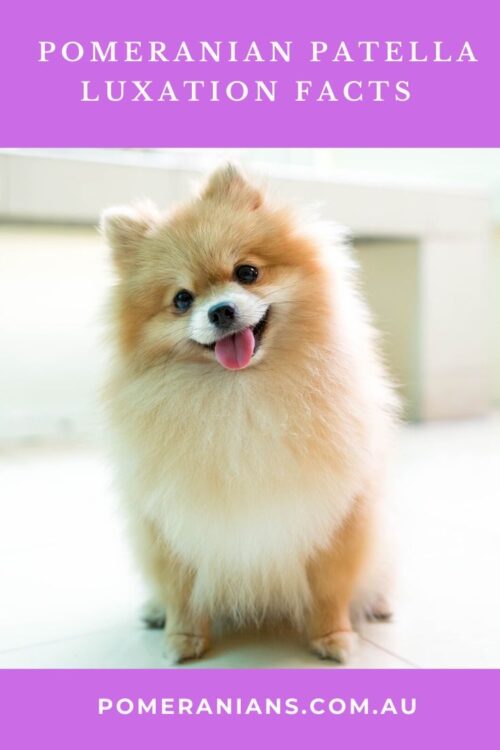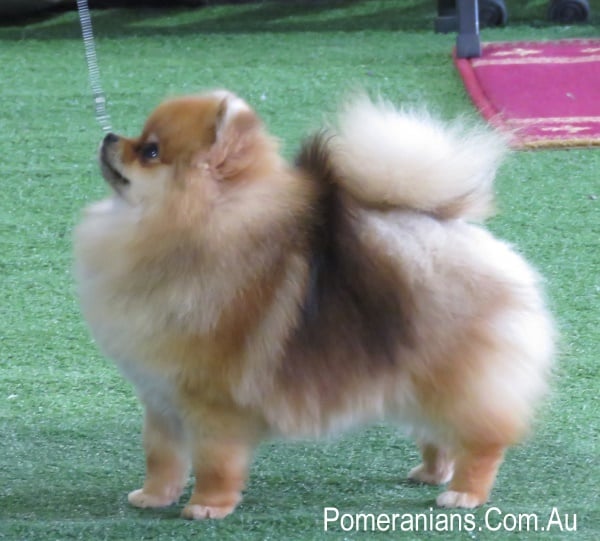Last Updated on April 8, 2022 by Denise Leo
It’s common for dogs to be susceptible to joint problems, especially with hips and knees. Pomeranians fall into this category so all owners of this breed need to be aware of risks, possibilities, choices and potential outcomes/success rates, particularly the statistics and success rate relating to luxating patella Pomeranian surgery.
Two questions owners of Pomeranians have is:
- Whether surgery is regarded as the only viable choice.
- Will surgery really fix the problem?
If you own a Pomeranian, you need to understand this physical problem. The knee has a tendency to rotate and slip; a luxating patella, because the kneecap (patella) moves out of its usual spot, and that causes the dog to suffer unnecessary pain. If your Pom has a luxating patella, he will have difficulty walking, jumping and running and you may have to help him with certain activities.
This condition also prevents your Pomeranian from playing with you or other dogs for fear of experiencing more pain and further damage. Because off this, you need to speak to your vet about urgent treatment and understanding the success rate of luxating patella surgery is a vital piece of information which can help you decide on the best treatment.
Pomeranian Patella Luxation Facts
Every small dog breed is regarded as a high-risk dog when you’re talking about kneecap and other knee joint issues. It often creeps up on you because your pet Pom might not have any indicators (such as pain and/or stiffness) until the first day when symptoms make themselves known. The ideal way to do it is to be aware of this risk but don’t go overboard and hinder your dog from enjoying his usual activities.

Monitor your Pom’s behaviour and ensure the vet checks his knees when doing a regular check-up. If he doesn’t have trouble moving and has no pain, let him enjoy life with you and others in the household. When you’re playing or taking him for walks, pay close attention if you notice even a fleeting moment of pain or stiffness, before it disappears once more
Pomeranian Luxating Patella Symptoms
There are some basic indicators. For example, your Pom may be running or walking the same way he always does, and then a little hop or skip that appears a little odd. Your Pomeranian may seem hesitant but then he moves normally once more
If this only happens once, and resolves itself, watch him closer and organize a check-up with the vet. If he has a luxating patella, it’s highly likely that his movement changes will keep happening and his pain is much more obvious. This can adversely affect the success of the luxating patella surgery.
One small hop is a sign that your Pomeranian’s kneecap has slid out of its proper space because he holds his leg up momentarily to ease the discomfort. The patella might just slide straight back in again, and that makes your excited Pom want to get going again. A bigger sign could happen immediately or it might take time. If he pauses and emits a cry or yelp, it’s certainly time for a trip to the vet.
Diagnosing a Luxating Patella
The vet will start by watching him move. Your kneecap sits on your leg in the same way that your Pomeranian’s sits on his legs. The kneecap keeps the thigh muscles moving smoothly and the ridges of the patella enable the kneecap to keep sliding for a correct movement in a knee joint that’s mechanically sound. It’s common for the patellar ridge of a Pomeranian to be very flat.
It’s simple for a Pom’s kneecap to pop out or in and, frequently it will also slide back into position on its own when it occurs that initial time. If the vet advises you that your Pomeranian has a luxating patella, he’ll most likely reveal the severity of the problem. In most cases, the vet can identify the correct grade (from 1 – 4) and the higher the number, the greater the severity. 0 mean no luxating patella was diagnosed at this examination.
- Grade 1 is mild and most of the time the problem will resolve itself.
- Grade 2 is a little more complicated. Sometimes your Pomeranian’s kneecap will slip back into its proper spot without help. However, there will be times when it’s stuck and will need manual repositioning, after which it should remain in place for a while.
- Grade 3 is applicable when your Pom’s kneecap pops out of alignment and can be repositioned manually, but it won’t remain in place for long.
- Grade 4 is applied to a Pomeranian with a patella that is out of place all the time. Knowing the correct grade will help determine how successful luxating patella surgery will be for your Pom.
Success Rate of Luxating Patella Surgery
Numerous vets suggest surgery at all levels. However, that doesn’t mean it’s the correct option, especially if your Pomeranian is only Grade 1 and there may be other solutions.
If he’s carrying extra weight and/or there hasn’t been any discussions for alternative therapies, consider physical therapy and weight loss options. If your Pom is regarded as a strong candidate for surgery, it’s in your best interest to know the rate of success and the level of improvement that is considered a success.
The two most common surgical procedures are:
A deepening of the trochlear wedge, where the surgeon creates a deeper “container” so the kneecap has extra room to remain in place. The other part of this surgery is where the surgeon tightens the joint capsule, which is often a key element in in ensuring the success rate of the luxating patella surgery.
Approximately 10% of Poms don’t demonstrate much improvement which is why it’s essential to know the success rate prior to starting. This is why you need to know that, despite the chances being minimal, it’s still knowledge you need to possess.
Every surgery has risks, whether it’s carried out on people or dogs. Risks may be related to anaesthetic and/or infections that can occur after the surgery.
The positive news is that if surgery is carried out before the condition has progressed, and your Pomeranian is still reasonably young and healthy, the success rate improves dramatically. Lots of Pomeranians live a long healthy life, relatively free of pain, while others need more surgeries to keep improving.
Increase Your Odds of a High Surgery Success Rate
Never feel nervous or scared about asking all the questions you want. Get all the different opinions as well. Check the background of the surgeon. Learn all you can about the success rate of the luxating patella surgery procedure. Check that the vet or orthopaedic surgeon you use is board-certified and that the person can show you proof (customer records) of plenty of successful surgical procedures.
If your Pomeranian’s health is more advanced, and he has other health concerns as well, ask am even longer list of questions. Unless he’s busy, no genuine vet or surgeon would refuse to answer questions.
The vet should be able to give you more information you may not have even thought about. For example: would the success rate of your Pomeranian’s luxating patella surgery be adversely affected by hip problems, arthritis, age or anything else.
If the doctor or vet appears confused or uncomfortable by the questions you’re asking, it would be wise to check other potential options. After all; you want to build a long-term relationship with this person and the results you and your Pomeranian would get will be much higher with a confident, more experienced surgeon/vet, rather than one who is very nervous about something.
References and Further Reading:
[1] ANKC Pomeranian Breed Standard.
[2] Denise Leo “The Pomeranian Handbook”.


